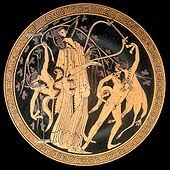subota, 5. lipnja 2010.
ARCHAEOLOGICAL SOURCES
The discovery of the Mycenaean civilization by the German amateur archaeologist, Heinrich Schliemann, in the nineteenth century, and the discovery of the Minoan civilization in Crete by British archaeologist, Sir Arthur Evans, in the twentieth century, helped to explain many existing questions about Homer's epics and provided archaeological evidence for many of the mythological details about gods and heroes. Unfortunately, the evidence about myth and ritual at Mycenaean and Minoan sites is entirely monumental, as the Linear B script (an ancient form of Greek found in both Crete and Greece) was used mainly to record inventories, although the names of gods and heroes doubtfully have been revealed. Geometric designs on pottery of the eighth century BC depict scenes from the Trojan cycle, as well as the adventures of Heracles. These visual representations of myths are important for two reasons. For one, many Greek myths are attested on vases earlier than in literary sources: of the twelve labors of Heracles, for example, only the Cerberus adventure occurs in a contemporary literary text. In addition, visual sources sometimes represent myths or mythical scenes that are not attested in any extant literary source. In some cases, the first known representation of a myth in geometric art predates its first known representation in late archaic poetry, by several centuries. In the Archaic (c. 750–c. 500 BC), Classical (c. 480–323 BC), and Hellenistic (323–146 BC) periods, Homeric and various other mythological scenes appear, supplementing the existing literary evidence.
Pretplati se na:
Objavi komentare (Atom)

Nema komentara:
Objavi komentar